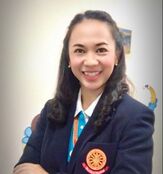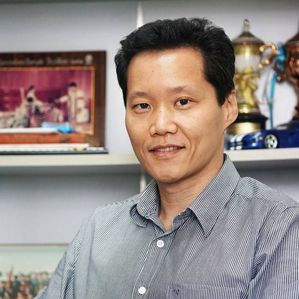|
Jinpitcha Mamom, An Innovative Repositioning Bed: Instrument for Preventing Pressure Ulcers, TNMC & WANS International Nursing Research Conference 2017, October 20-22, 2017 Introduction: A pressure ulcer, also known as pressure sore, decubitus ulcer, or bedsore, can be defined as a localized injury to the skin/ tissue occurring most often over a bony prominence and caused by mechanical loading: pressure, shearing, or friction. Pressure ulcers are a common cause of complications among immobilized patients that the immobilization is acceptable caused localized ischemia, which is a result of tissue deformation related to prolonged loading.
Objectives: To develop an innovative repositioning bed that promotes patients’ proper postures and positions, and to evaluate its efficacy in reducing ischemia, which can lead to tissue hypoxia, cell death, and pressure ulcer development. Methods and Results: This new innovative bed differs from a conventional hospital bed, as the movement of the patient to the left or the right, and also the raising of the head and knees, can be controlled in order to prevent pressure ulcers. This is compatible with the NPUAP (2014) principle of the clinical practice guideline on pressure ulcer prevention. This bed design has 0-30 degrees of movement for the head level, 0-45 degrees for the knee level, and 30 degrees of lateral tilt to reduce interface pressure on the bony prominences, preventing friction and shearing force and thus allowing higher tissue perfusion and blood flow. Conclusion: The repositioning of immobile patients is an important standard nursing practice that is based on the principle of mechanical loading management, including redistributing interface pressures, decreasing shearing stress, and reducing skin temperature. This innovative repositioning bed was developed based on physics for nursing science and on nursing standards in order to effectively enable patients to properly reposition themselves at proper angles and in proper positions. This innovative bed could be used to prevent pressure ulcers that are complications in the growing population of elderly patients incapable of repositioning themselves
0 Comments
Supachai Vorapojpisut, “Model-based Design of PEMS for Medical Devices”, The 11st international Convention on Rehabilitation Engineering and Assistive Technology (i-CREATe 2017), August 22-24, 2017 ABSTRACT
This paper addresses the software design and implementation of Programmable Electrical Medical Systems (PEMS) for medical devices according to the IEC 60601-1 standard. The standard involves many aspects of medical products’ life cycle in which Clause 14 emphasizes on risk management of safety features that depend on software or any programmable element. The software design for an infant incubator is outlined to demonstrate major issues that can arise in safety-related functions. Then model-based design based on MATLAB/Simulink has been proposed as an approach to realize safety requirements. Finally, this paper discusses the claim of safety evidence using the model as executable documents. The 2017 International Conference on Embedded Systems and Intelligent Technology (ICESIT 2017)8/2/2017 Supachai Vorapojpisut, Permsap Munborirux, Siraphop Laosuarpa, Suwarang Jaisamer “Project-based Learning in the AMAS-MBD 2016”, The 2017 International Conference on Embedded Systems and Intelligent Technology (ICESIT 2017), August 2-4, 2017e to edit. Abstract
This paper presents our outcomes and experience from the participation in the Annual Student Meeting on Automotive Embedded Systems (AMAS) event. Using project-based learning concept, features in vehicle control and advanced driver-assistance systems were formulated as the design problem for the 2016 event. Our approach to solve the problem statement is based on the tele-operated vehicle framework, i.e. driving with first-person view. The development of three Simulink models for microcontroller board, Raspberry Pi board, and PC are explained as our learning outcomes. Then experienced issues are discussed for further improvement. วรัตถ์ สิทธิ์เหล่าถาวร และ บรรยงค์ รุ่งเรืองด้วยบุญ, "การออกแบบโครงช่วยฝึกเดินที่มีระบบพยุงน้าหนักบางส่วนส้าหรับผู้ที่มีปัญหาการเคลื่อนไหวด้านการเดิน : Space Walker" การประชุมวิชาการเครือข่ายวิศวกรรมเครื่องกลแห่งประเทศไทย ครั้งที่ 31, 4 – 7 กรกฎาคม 2560 จังหวัดนครนายก บทคัดย่อ
งานวิจัยที่น้าเสนอนี้เป็นงานวิจัยเพื่อออกแบบและพัฒนาอุปกรณ์ช่วยเดินแบบพยุงน้้าหนักบางส่วนส้าหรับผู้ที่มีปัญหาการเคลื่อนไหวด้านการเดิน เช่น กลุ่มผู้ป่วยโรคหลอดเลือดสมอง, กลุ่มผู้ป่วยโรคกล้ามเนื้ออ่อนแรง, กลุ่มผู้สูงอายุ โดยผู้วิจัยได้เริ่มต้นการวิจัยและพัฒนาอุปกรณ์ช่วยฝึกเดินแบบพยุงน้้าหนักบางส่วน โดยโครงการนี้เกิดขึ้นเพื่อแก้ไขปัญหาการฝึกเดินหลังจากที่ผู้ป่วยผ่านการฝึกเดิน หรือใช้เทคโนโลยีหุ่นยนต์ช่วยฝึกเดินมาแล้ว จนมีระดับความสามารถการเดินที่ดีขึ้นในระดับหนึ่ง ซึ่งหมายถึง ผู้ป่วยพอที่จะช่วยเหลือตัวเอง หรือก้าวขาได้ด้วยตัวเองได้ (ค่า FAC ระดับ 3-5) หลังจากขั้นตอนนี้ผู้ป่วยจะต้องฝึกเดินให้บ่อยที่สุด โดยใช้โครงช่วยฝึกเดิน (Walker) ซึ่งจะท้าให้มัดกล้ามเนื้อแข็งแรง แต่ปัญหาที่เกิดขึ้น คือ การหกล้ม ซึ่งเกิดจากอุปกรณ์ไม่มีระบบพยุงน้้าหนัก และเนื่องจากผู้ป่วยที่มีปัญหาด้านการเคลื่อนไหวจะมีความพิการหลงเหลืออยู่ ท้าให้ส่งผลต่อการเคลื่อนไหวร่างกายและรูปแบบการเดิน ท้าให้เสี่ยงต่อการหกล้มเพิ่มขึ้นเป็น 2-3 เท่า เมื่อเทียบกับประชากรกลุ่มอายุเดียวกัน ซึ่งการแก้ไขปัญหาการหกล้มได้นั้น ก็คือการฝึกเดิน เพื่อช่วยเสริมสร้างความแข็งแรงของกล้ามเนื้อ และป้องกันการหกล้ม ซึ่งวิธีนี้ได้รับการพิสูจน์ทางวิชาการแล้วว่า ช่วยป้องกันการหกล้มได้ดีที่สุด ดังนั้นงานวิจัยชิ้นนี้จึงมุ่งเน้นในการออกแบบและพัฒนาอุปกรณ์ช่วยฝึกเดินเพื่อแก้ปัญหาที่กล่าวมา โดยตัวอุปกรณ์ที่ออกแบบนั้น ประกอบด้วย 2 ส่วน คือ 1. ระบบพยุงน้้าหนักบางส่วน แบบไดนามิกส์ (Dynamic Partial Weight Support System) โดยใช้แก๊สสปริงท้าหน้าที่พยุงน้้าหนัก เพื่อช่วยพยุงน้้าหนักบางส่วนของผู้ป่วย โดยปรับระดับแรงพยุงน้้าหนักได้โดยการปรับมุมเอียงทิ่ใช้ติดตั้งแก๊สสปริง 2. ชุดสวมใส่ที่ออกแบบพิเศษส้าหรับยกพยุงตัว เพื่อให้เกิดความสบาย และถูกต้องตามหลักการฝึกเดิน จากผลการทดสอบอุปกรณ์ต้นแบบ พบว่า อุปกรณ์สามารถพยุงน้้าหนักตัวผู้ป่วยได้ตามที่ออกแบบไว้ และสามารถช่วยเหลือผู้ป่วยให้การฝึกเดินด้วยอุปกรณ์ช่วยฝึกเดินเป็นเรื่องที่ง่ายขึ้น Yomchinda T. and Cholaseuk, D., 2015, Modelling of Tire Response for the Study of Speed Bump Profiles, Proceeding of the 29th Conference of The Mechanical Engineering Network of Thailand, Paper number CST-1422537978
Treemongkol, W., Cholaseuk D. and Thongsawatwong, 2014, Development of Tamarind Seed Sheller, Proceedings of the 9th Sripathum University Conference, December 2014
|
HoursM-F: 7am - 7pm
|
Telephone+66-(0)-2564-3001 ถึง 9 ต่อ 3247
|
|






 RSS Feed
RSS Feed